Causality Analysis and Risk Assessment of Haze Disaster in Beijing
Abstract
:1. Introduction
2. Materials and Methods
2.1. Analysis Model of Haze System
2.2. Causal Analysis of Influencing Factors
2.3. Nonlinear Dynamical Models
3. Results and Discussion
3.1. Comparison and Analysis of Governance Strategies
3.2. Combination of Coordinated Governance Policy in Beijing
3.3. Combination of Cross Regional Collaborative Governance Policy
3.4. Suggestions on Haze Controlling of Multiple Urban Regions
4. Conclusions
Author Contributions
Funding
Institutional Review Board Statement
Informed Consent Statement
Data Availability Statement
Conflicts of Interest
References
- Zhou, Y.J.; Zhou, J.X.; Xiao, R.B. System Dynamics Modeling for Prediction of Impacts on GDP and PM2.5 by Regional Air Pollutants Emission Reduction. Environ. Sci. Technol. 2016, 39, 161–167. [Google Scholar]
- Li, Z.F.; Yan, G.L. Analysis on the Fuel Consumption of Automobile in Shanghai Based on System Dynamics. J. Univ. Shanghai Sci. Technol. 2016, 38, 357–361. [Google Scholar]
- Li, S.W.; Chang, M.; Li, H.; Cui, X.Y.; Ma, L.Q. Chemical compositions and source apportionment of PM2.5 during clear and hazy days: Seasonal changes and impacts of Youth Olympic Games. Chemosphere 2020, 256, 127163. [Google Scholar] [CrossRef]
- Liu, Y.; Wu, J.; Yu, D.; Ma, Q. The relationship between urban form and air pollution depends on seasonality and city size. Environ. Sci. Pollut. 2018, 25, 145–162. [Google Scholar] [CrossRef] [PubMed]
- Su, C.W.; Li, Z.Z.; Tao, R.; Si, D.K. Testing for multiple bubbles in bitcoin markets: A generalized sup ADF test. Jpn. World Econ. 2020, 53, 56–63. [Google Scholar] [CrossRef]
- Wang, S.; Li, S.; Xing, J.; Yang, J.; Dong, J.; Qin, Y.; Sahu, S.K. Evaluation of the influence of El Nino-Southern Oscillation on air quality in southern China from long-term historical observations. Front. Environ. Sci. Eng. 2022, 16, 406–425. [Google Scholar] [CrossRef]
- Cai, W.; Li, K.; Liao, H.; Wang, H.; Wu, L. Weather conditions conducive to Beijing severe haze more frequent under climate change. Nat. Clim. Chang. 2017, 7, 257–262. [Google Scholar] [CrossRef]
- Cai, W.; Wang, G.; Dewitte, B.; Wu, L.; Santoso, A.; Takahashi, K.; McPhaden, M.J. Increased variability of eastern Pacific El Niño under greenhouse warming. Nature 2018, 564, 201–206. [Google Scholar] [CrossRef] [PubMed]
- Chang, L.; Xu, J.; Tie, X.; Wu, J. Impact of the 2015 El Niño event on winter air quality in China. Sci. Rep. 2016, 6, 34275. [Google Scholar] [CrossRef] [PubMed]
- Ding, D.; Xing, J.; Wang, S.; Chang, X.; Hao, J. Impacts of emissions and meteorological changes on China’s ozone pollution in the warm seasons of 2013 and 2017. Front. Env. Sci. Eng. 2019, 13, 76. [Google Scholar] [CrossRef]
- Ding, D.; Xing, J.; Wang, S.; Liu, K.; Hao, J. Estimated contributions of emissions controls, meteorological factors, population growth, and changes in baseline mortality to reductions in ambient PM2.5 and PM2.5-related mortality in China, 2013–2017. Environ. Health Perspect. 2019, 127, 67009. [Google Scholar] [CrossRef] [PubMed]
- Ding, Y.; Wu, P.; Liu, Y.; Song, Y. Environmental and dynamic conditions for the occurrence of persistent haze events in North China. Engineering 2017, 3, 266–271. [Google Scholar] [CrossRef]
- Feng, J.; Li, J.; Zhu, J.; Liao, H. Influences of El Nino Modoki event 1994/1995 on aerosol concentrations over southern China. J. Geophys. Res. Atmos. 2016, 121, 1637–1651. [Google Scholar] [CrossRef]
- Feng, J.; Li, J.; Zhu, J.; Liao, H.; Yang, Y. Simulated contrasting influences of two La Niña Modoki events on aerosol concentrations over eastern China. J. Geophys. Res. Atmos. 2017, 122, 2734–2749. [Google Scholar] [CrossRef]
- Jiang, Y.; Xing, J.; Wang, S.; Chang, X.; Liu, S.; Shi, A.; Sahu, S.K. Understand the local and regional contributions on air pollution from the view of human health impacts. Front. Environ. Sci. Eng. 2021, 15, 11. [Google Scholar] [CrossRef]
- Liu, T.; Gong, S.; He, J.; Yu, M.; Wang, Q.; Li, H.; Zhao, Q. Attributions of meteorological and emission factors to the 2015 winter severe haze pollution episodes in China’s Jing-Jin-Ji area. Atmos. Chem. Phys. 2017, 17, 2971–2980. [Google Scholar] [CrossRef]
- Ma, T.; Duan, F.; He, K.; Qin, Y.; Tong, D.; Geng, G.; Ma, Y. Air pollution characteristics and their relationship with emissions and meteorology in the Yangtze River Delta region during 2014–2016. J. Environ. Sci. 2019, 83, 8–20. [Google Scholar] [CrossRef]
- Dhaka, S.K.; Dang, C.; Kumar, V.; Panwar, V.; Dimri, A.P.; Singh, N.; Patra, P.K.; Hayashida, S. PM2.5 diminution and haze events over Delhi during the COVID-19 lockdown period: An interplay between the baseline pollution and meteorology. Sci. Rep. 2020, 10, 1–8. [Google Scholar] [CrossRef]
- Yousefian, F.; Faridi, S.; Azimi, F.; Aghaei, M.; Shamsipour, M.; Yaghmaeian, K.; Hassanvand, M.S. Temporal variations of ambient air pollutants and meteorological influences on their concentrations in Tehran during 2012–2017. Sci. Rep. 2020, 10, 13442. [Google Scholar] [CrossRef]
- Sugihara, G. Detecting causality in complex ecosystems. Science 2012, 338, 496–500. [Google Scholar] [CrossRef]
- Sethi, J.K.; Mittal, M. A new feature selection method based on machine learning technique for air quality dataset. J. Stat. Manag. Syst. 2019, 22, 697–705. [Google Scholar] [CrossRef]
- Bagoulla, C.; Guillotreau, P. Maritime transport in the French economy and its impact on air pollution: An input-output analysis. Mar. Policy 2020, 116, 103818. [Google Scholar] [CrossRef]
- Mosedale, T.J.; Stephenson, D.B.; Collins, M.; Mills, T.C. Granger causality of coupled climate processes: Ocean feedback on the North Atlantic Oscillation. J. Clim. 2019, 19, 1182–1194. [Google Scholar] [CrossRef]
- Amann, M.; Klimont, Z.; Wagner, F. Regional and global emissions of air pollutants: Recent trends and future scenarios. Annu. Rev. Environ. Resour. 2013, 38, 31–55. [Google Scholar] [CrossRef]
- An, Z.; Huang, R.; Zhang, R.; Tie, X.; Li, G.; Cao, J.; Ji, Y. Severe haze in northern China: A synergy of anthropogenic emissions and atmospheric processes. Proc. Natl. Acad. Sci. USA 2019, 116, 8657–8666. [Google Scholar] [CrossRef]
- Wang, B.; Liu, S.; Du, Q.; Yan, Y. Long term causality analyses of industrial pollutants and meteorological factors on PM2.5 concentrations in Zhejiang Province. ICISCE 2018, 5, 301–305. [Google Scholar]
- Kuerban, M. Spatio-temporal patterns of air pollution in China from 2015 to 2018 and implications for health risks. Environ. Pollut. 2020, 258, 113659. [Google Scholar] [CrossRef]
- Olmo, N.R.S.; Saldiva, P.H.N.; Braga, A.L.F.; Lin, C.A.; de Paula Santos, U.; Pereira, L.A.A. A review of low-level air pollution and adverse effects on human health: Implications for epidemiological studies and public policy. Clinics 2011, 66, 681–690. [Google Scholar] [CrossRef]
- Xu, B.; Luo, L.; Lin, B. A dynamic analysis of air pollution emissions in China: Evidence from nonparametric additive regression models. Ecol. Indic. 2016, 63, 346–358. [Google Scholar] [CrossRef]
- Ong, B.T.; Sugiura, K.; Zettsu, K. Dynamically pre-trained deep recurrent neural networks using environmental monitoring data for predicting PM2.5. Neural Comput. Appl. 2016, 27, 1553–1566. [Google Scholar] [CrossRef]
- Xue, T.; Zheng, Y.; Tong, D.; Zheng, B.; Li, X.; Zhu, T.; Zhang, Q. Spatiotemporal continuous estimates of PM2.5 concentrations in China, 2000–2016: A machine learning method with inputs from satellites, chemical transport model, and ground observations. Environ. Int. 2019, 123, 345–357. [Google Scholar] [CrossRef] [PubMed]
- Zhou, Q.; Jiang, H.; Wang, J.; Zhou, J. A hybrid model for PM2.5 forecasting based on ensemble empirical mode decomposition and a general regression neural network. Sci. Total Environ. 2014, 496, 264–274. [Google Scholar] [CrossRef] [PubMed]
- Zhou, W.; Wu, X.; Ding, S.; Ji, X.; Pan, W. Predictions and mitigation strategies of PM2. 5 concentration in the Yangtze River Delta of China based on a novel nonlinear seasonal grey model. Environ. Pollut. 2021, 276, 116614. [Google Scholar] [CrossRef] [PubMed]
- Zhou, H.; Zhang, F.; Du, Z.; Liu, R. A theory-guided graph networks based PM2. 5 forecasting method. Environ. Pollut. 2021, 21, 118569. [Google Scholar]
- Seinfeld, J.H. Air pollution: A half century of progress. AIChE J. 2004, 50, 1096–1108. [Google Scholar] [CrossRef]
- Zhu, T.; Shang, J.; Zhao, D.F. The roles of heterogeneous chemical processes in the formation of an air pollution complex and gray haze. Sci. China Chem. 2011, 54, 145–153. [Google Scholar] [CrossRef]
- Zlatev, Z.; Christensen, J.; Hov, Ø. A Eulerian air pollution model for Europe with nonlinear chemistry. J. Atmos. Chem. 1992, 15, 1–37. [Google Scholar] [CrossRef]
- Ivakumar, B.; Wallender, W.W.; Horwath, W.R.; Mitchell, J.P. Nonlinear deterministic analysis of air pollution dynamics in a rural and agricultural setting. Adv. Complex Syst. 2007, 10, 581–597. [Google Scholar] [CrossRef]
- Harirchain, E.; Hosseini, S.E.A.; Jadhav, K.; Kumari, V.; Rasulzade, S.; Işık, E.; Lahmer, T. A review on application of soft computing techniques for the rapid visual safety evaluation and damage classification of existing buildings. J. Build. Eng. 2021, 43, 102536. [Google Scholar] [CrossRef]
- Ngo, D.; Lee, G.D.; Kang, B. Haziness degree evaluator: A knowledge-driven approach for haze density estimation. Sensors 2021, 21, 3896. [Google Scholar] [CrossRef]
- Yuan, Y.; Fan, B. Protective consumption behavior under smog: Using a data-driven dynamic Bayesian network. Res. Sq. 2021, 7, 1203. [Google Scholar]
- Kumari, V.; Harirchian, E.; Lahmer, T.; Rasulzade, S. Evaluation of machine learning and web-based process for damage score estimation of existing buildings. Buildings 2022, 12, 578. [Google Scholar] [CrossRef]
- Yin, J.T.; Ren, X.L.; Liu, R.H.; Tang, T.; Su, S. Quantitative analysis for resilience-based urban rail systems: A hybrid knowledge-based and data-driven approach. Reliab. Eng. Syst. Saf. 2022, 219, 108183. [Google Scholar] [CrossRef]
- Shang, D.; Peng, J.; Guo, S.; Wu, Z.; Hu, M. Secondary aerosol formation in winter haze over the Beijing-Tianjin-Hebei Region, China. Front. Environ. Sci. Eng. 2021, 15, 13. [Google Scholar] [CrossRef]
- Zhang, X.B.; Yu, B. Grey correlation analysis of PM2.5 in Beijing based on social factors. Environ. Prot. 2020, 48, 60–66. [Google Scholar]
- Zhang, X.B.; Ning, M.; Yu, B. Grey Analysis of PM2.5 pollution driving factors in Beijing-Tianjin-Hebei region based on Granger causality. Environ. Prot. 2020, 48, 59–64. [Google Scholar]
- China Yearbook Full-Text Database. Available online: https://lib.wbu.edu.cn/2178/list.htm (accessed on 17 November 2021).
- Source Analysis Results of PM2.5 in Beijing. Available online: http://sthjj.beijing.gov.cn/bjhrb/index/xxgk69/sthjlyzwg/fthg/11143030/index.html (accessed on 20 January 2022).
- Beijing Air Pollution: Real-Time Air Quality Index. Available online: https://aqicn.org/city/beijing/cn/ (accessed on 5 May 2022).



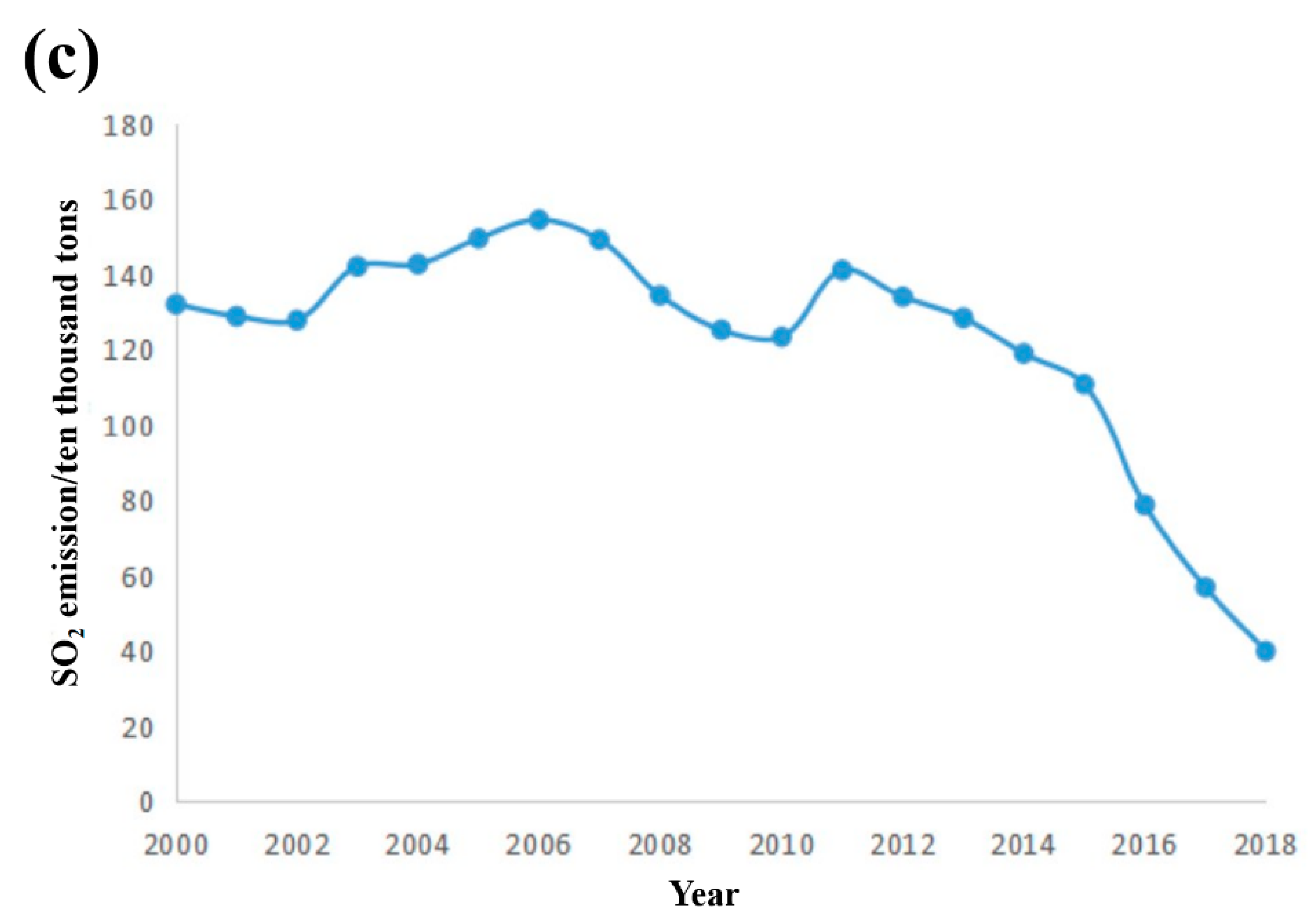
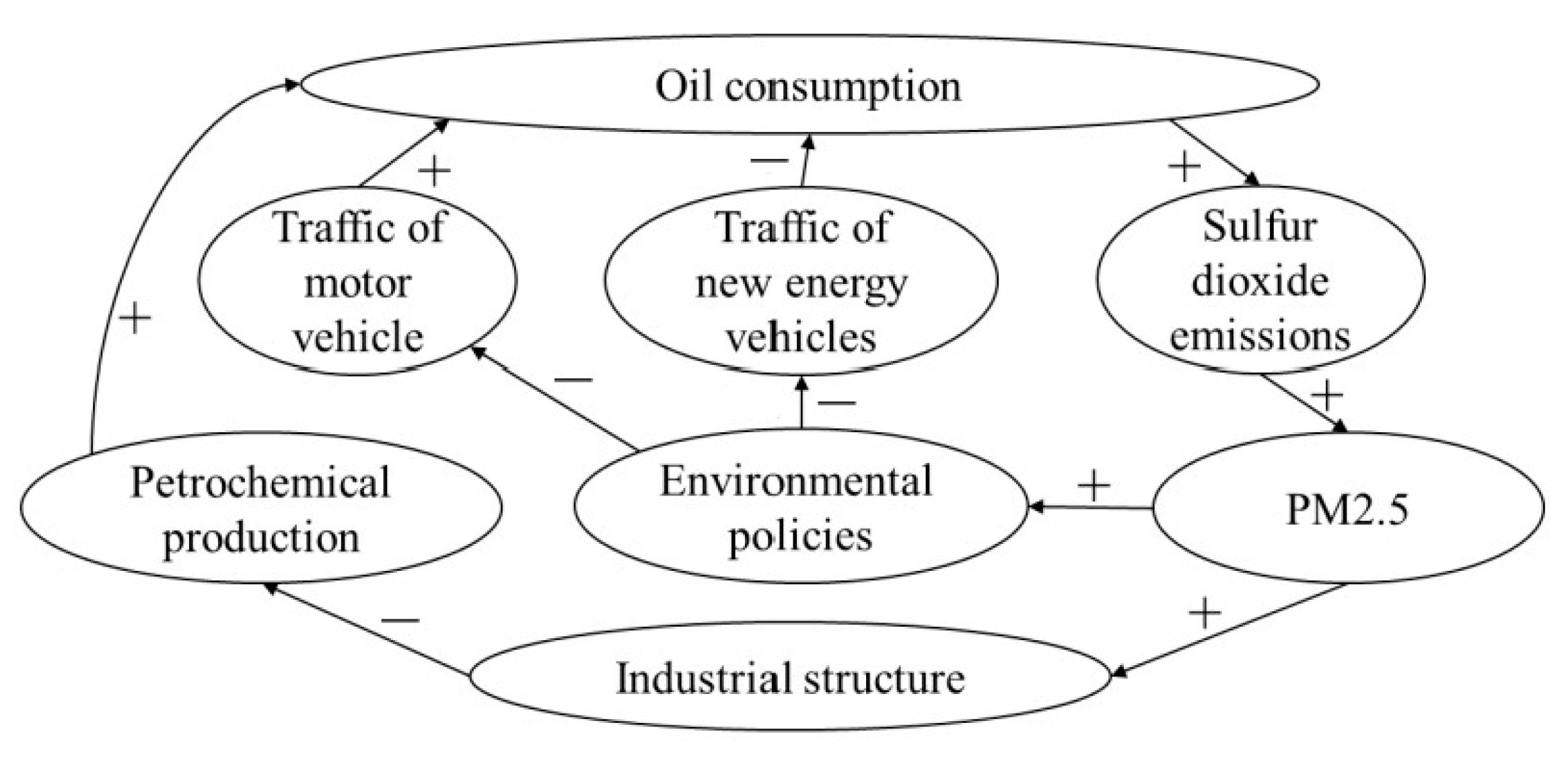
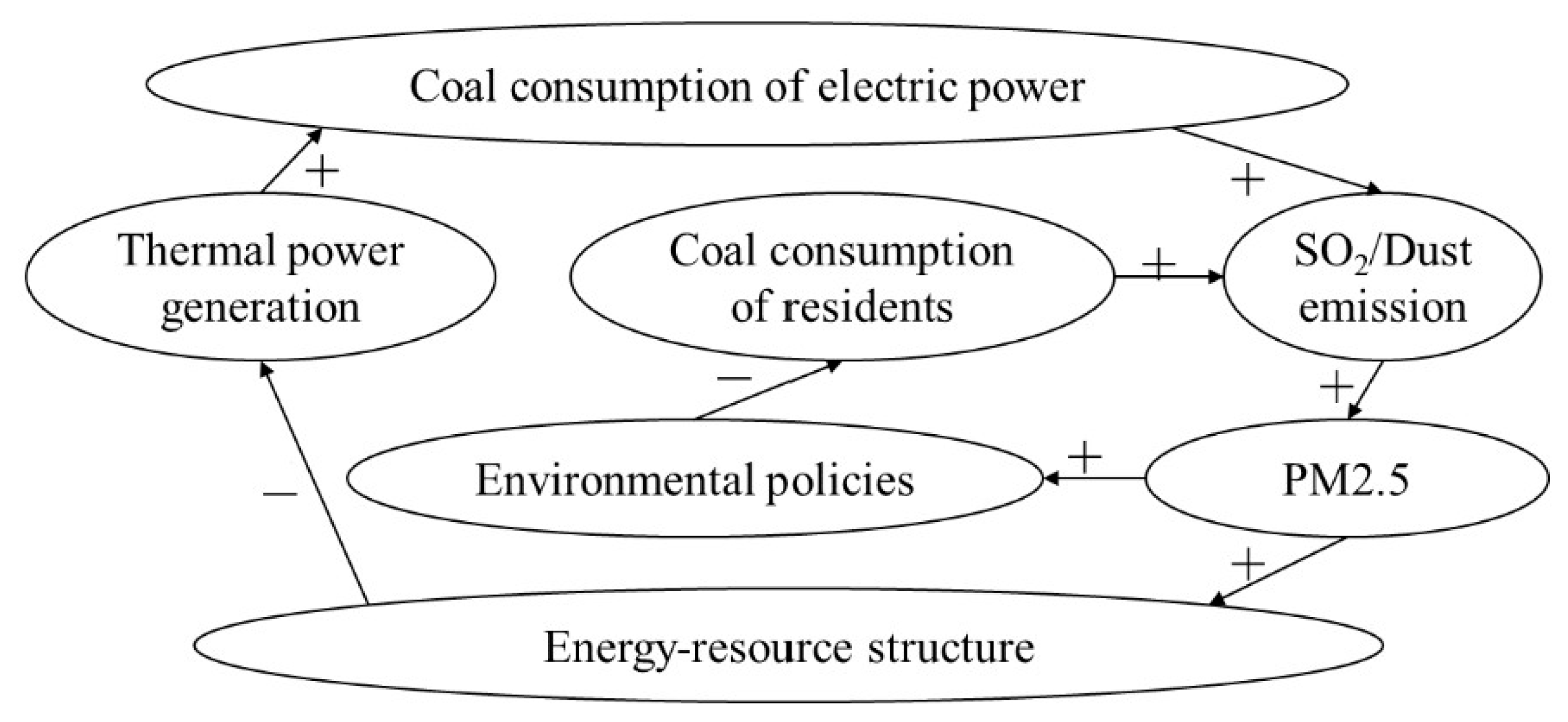
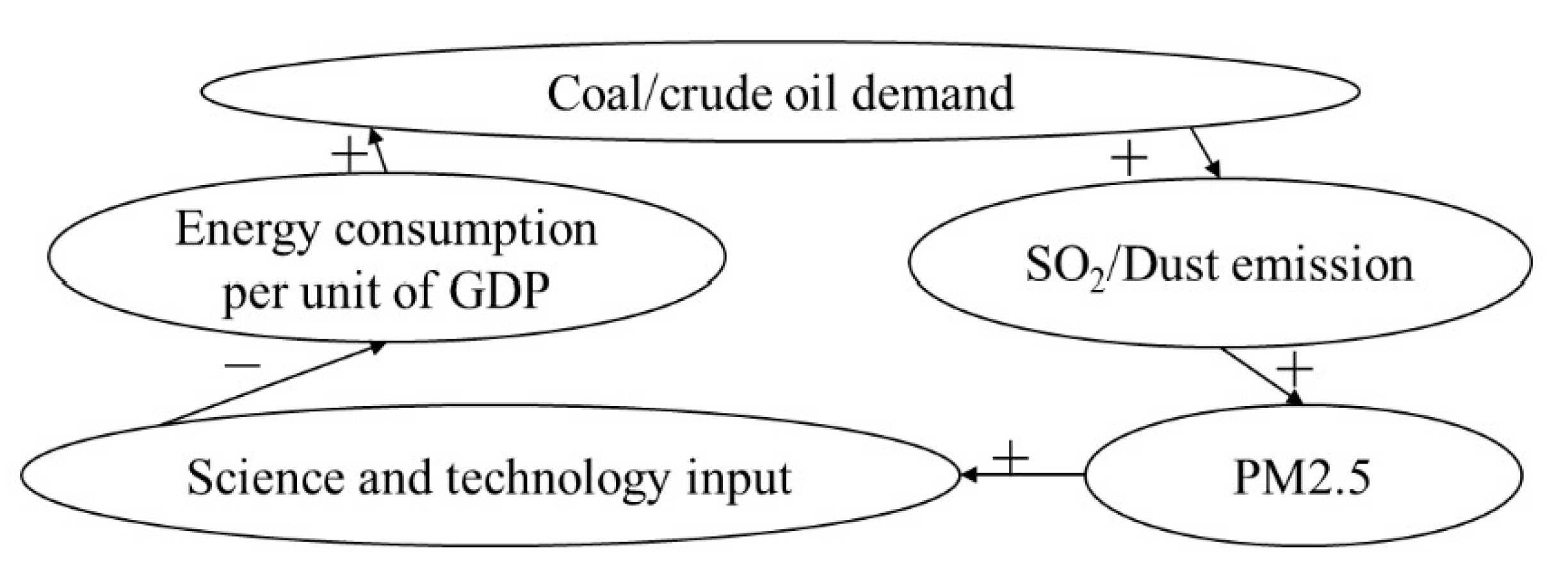
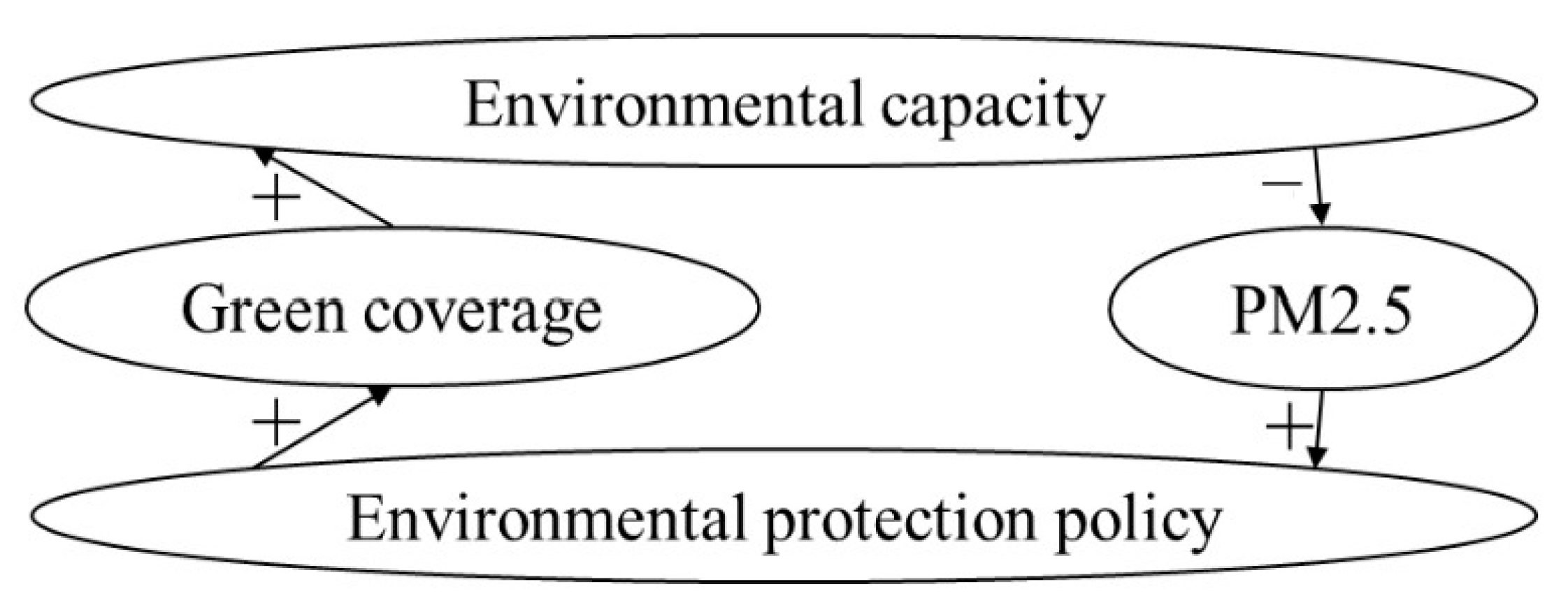



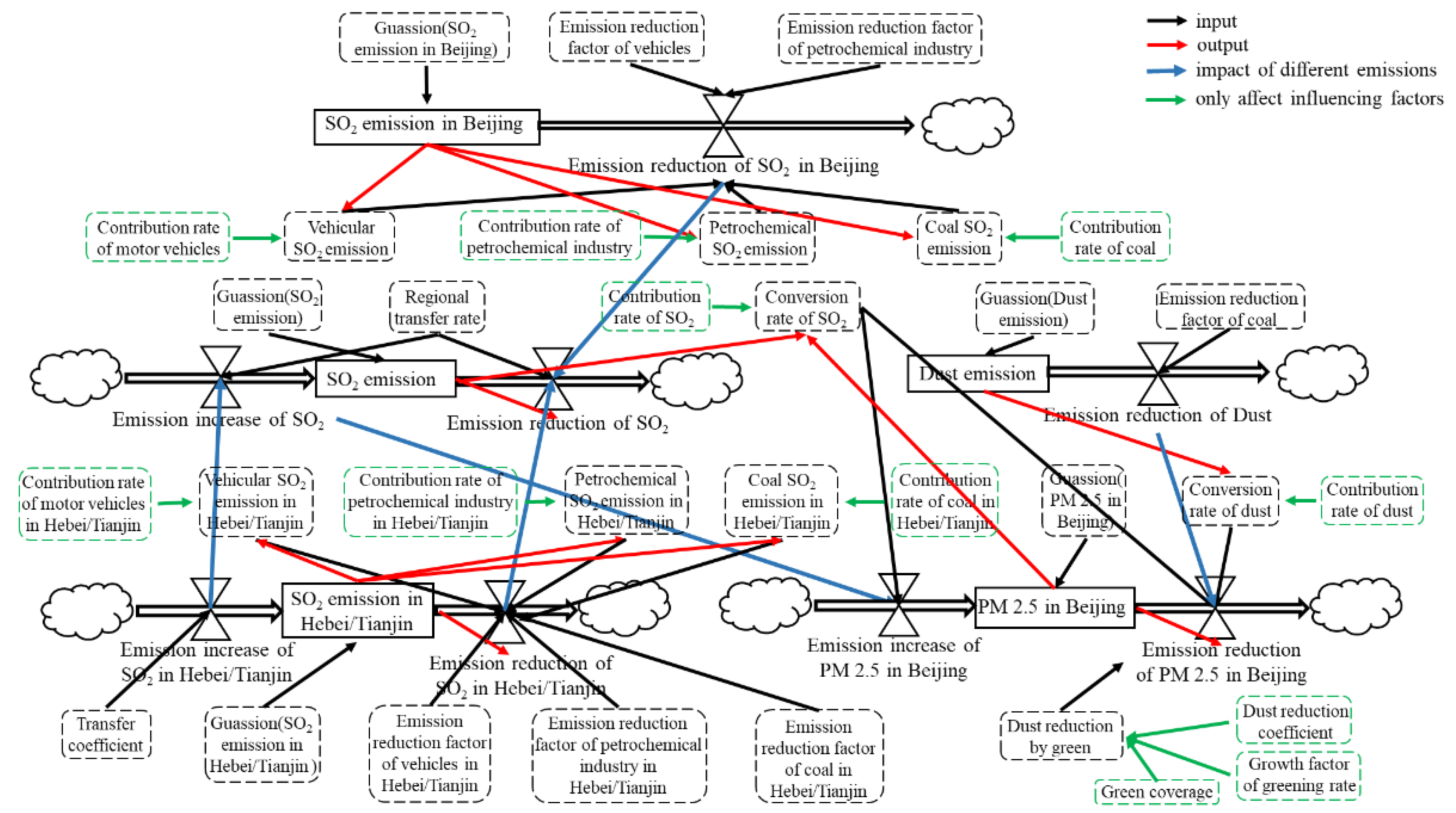
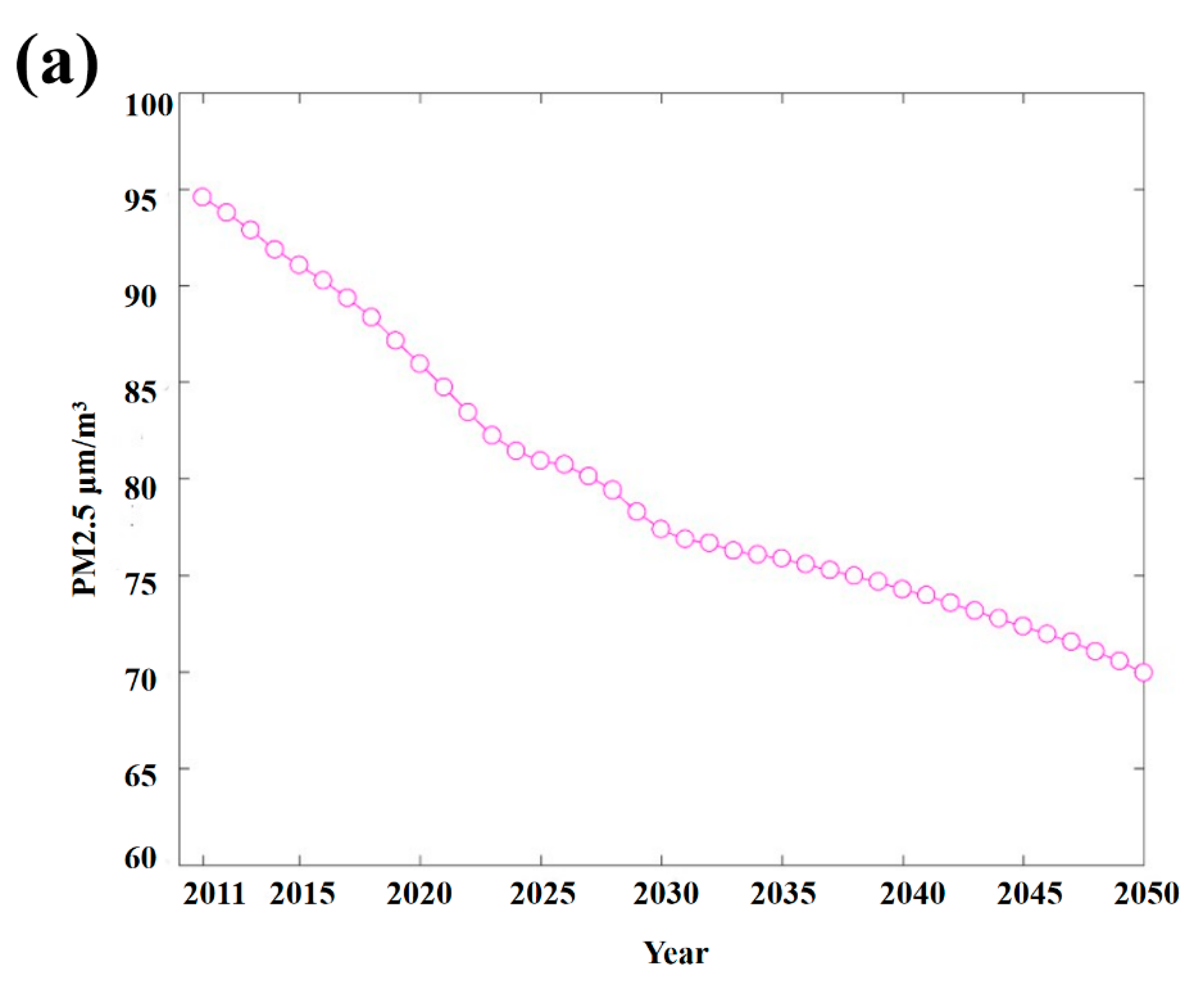
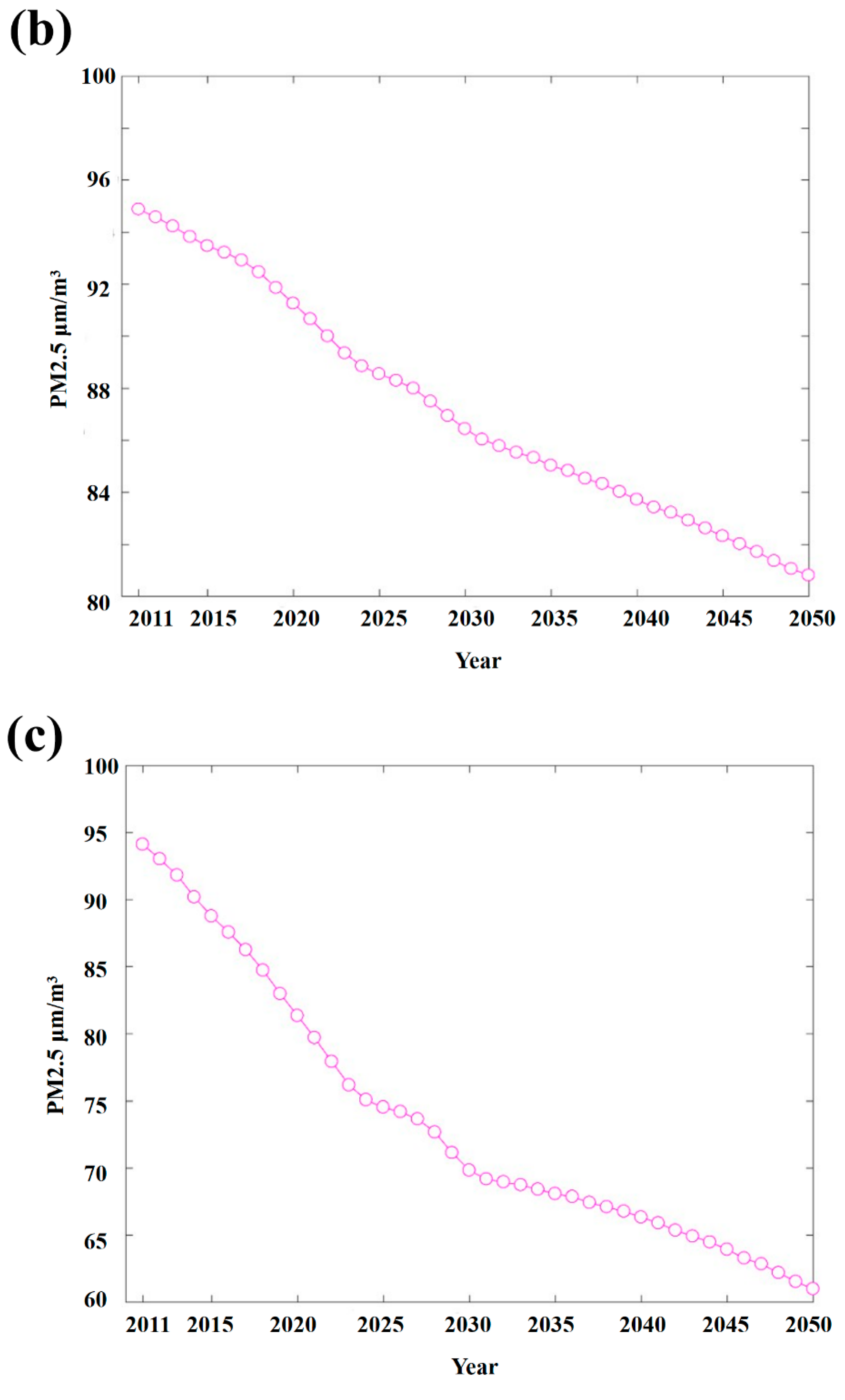
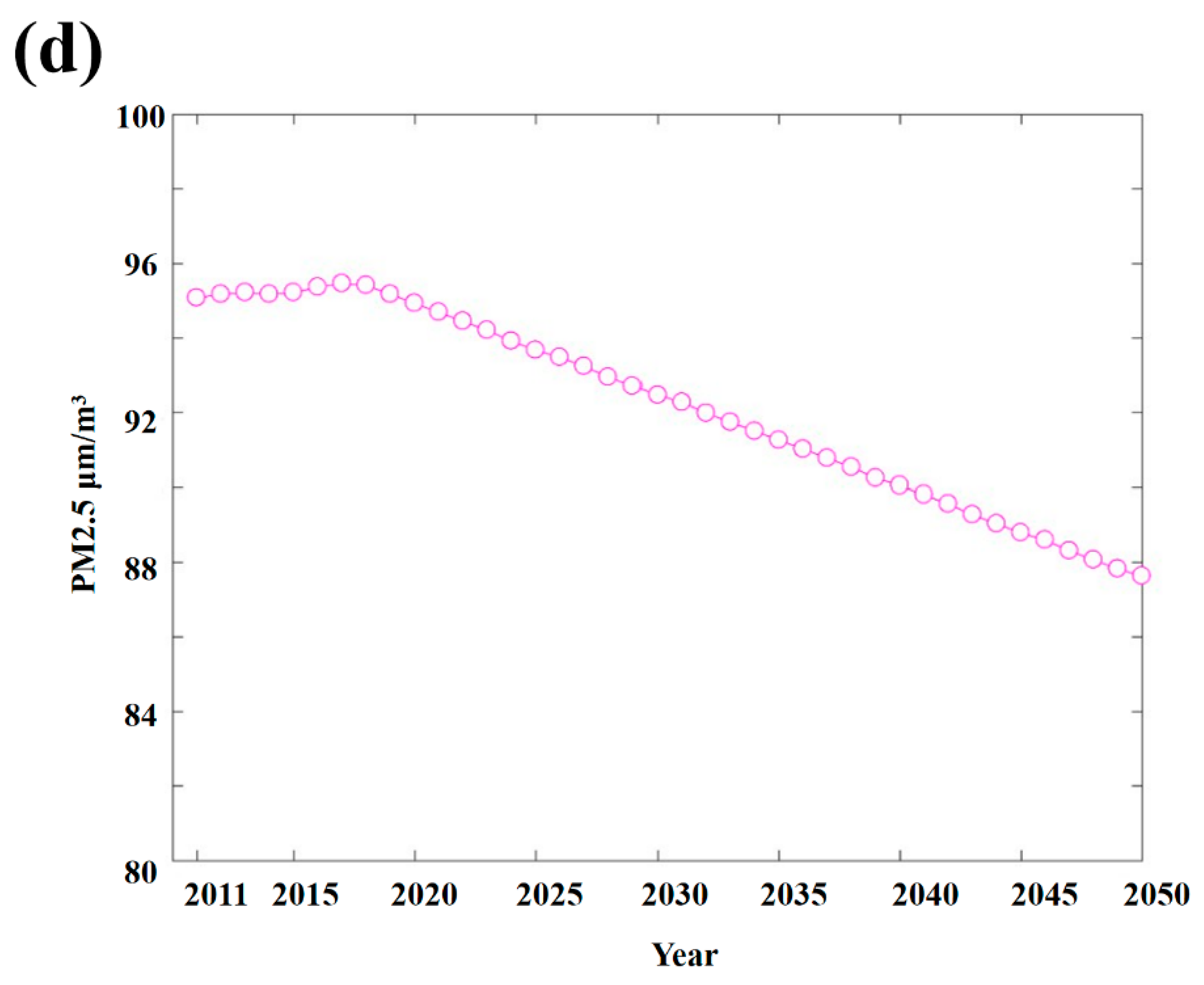
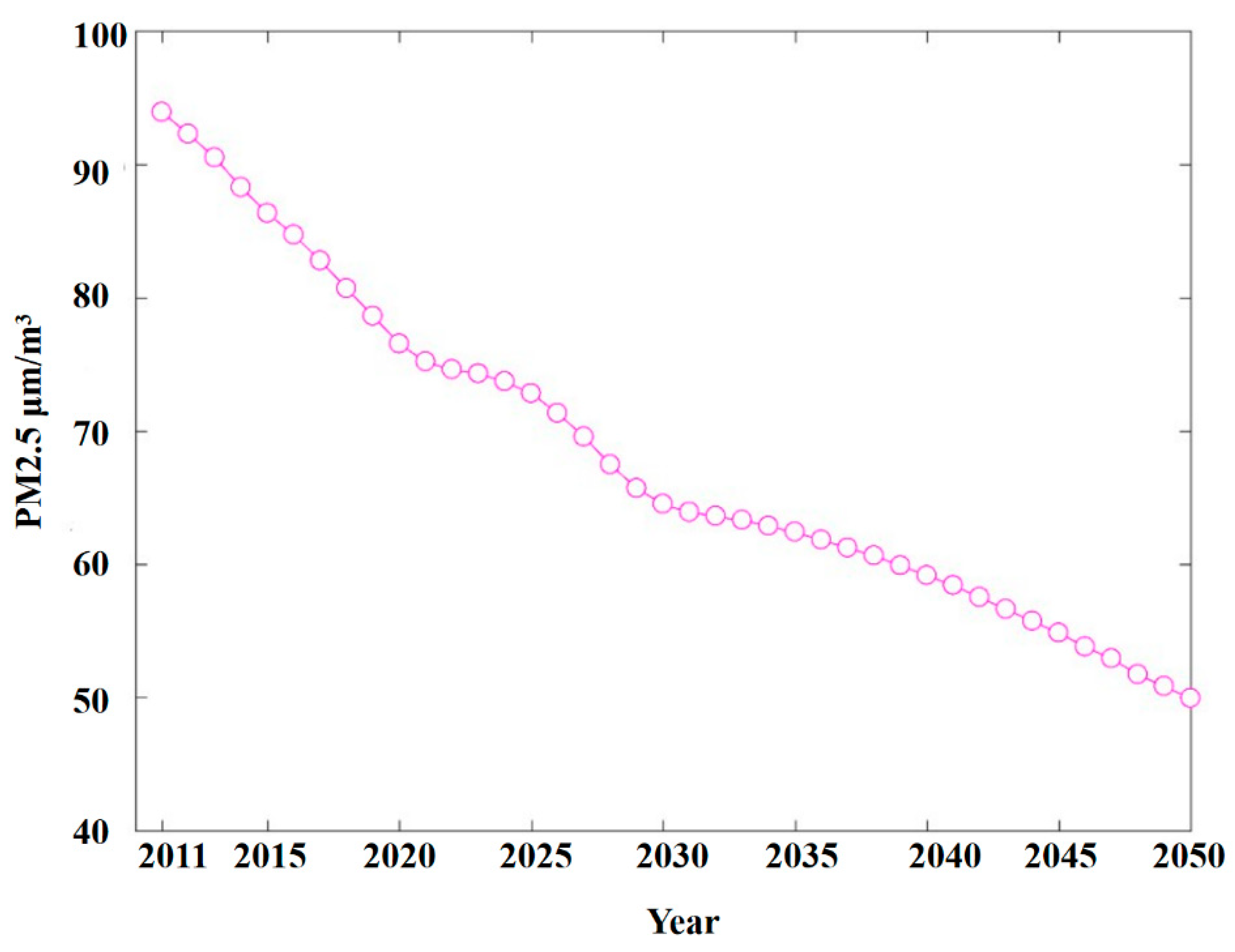

| Year | Output | Actual Value | Simulation Value | Relative Error |
|---|---|---|---|---|
| 2012 | PM2.5 | 92 | 91.23 | −0.84% |
| 2013 | PM2.5 | 89 | 87.48 | 2.24% |
| 2014 | PM2.5 | 86 | 83.50 | −2.90% |
| 2015 | PM2.5 | 81 | 79.50 | −1.85% |
| 2016 | PM2.5 | 73 | 75.61 | 3.58% |
| 2017 | PM2.5 | 68 | 66.79 | 1.78% |
| Parameter | Value |
|---|---|
| Contribution rate of SO2 | 0.38 |
| Contribution rate of dust | 0.62 |
| Contribution rate of motor vehicle | 0.65 |
| Contribution rate of petrochemical industry | 0.23 |
| Contribution rate of coal | 0.12 |
| Dust reduction coefficient | 2.14 |
| Regional transfer rate | 0.03 |
| Transfer coefficient | 0.40 |
| Contribution rate of motor vehicle in Hebei/Tianjin | 0.50 |
| Contribution rate of petrochemical industry in Hebei/Tianjin | 0.23 |
| Contribution rate of coal in Hebei/Tianjin | 0.27 |
| Governance Strategy | Emission Reduction Factor of Vehicle | Emission Reduction Factor of Petrochemical Industry | Emission Reduction Factor of Coal | Growth Factor of Greening Rate | Emission Reduction Factor of Vehicle in Hebei/Tianjin | Emission Reduction Factor of Petrochemical Industry in Hebei/Tianjin | Emission Reduction Factor of Coal in Hebei/Tianjin |
|---|---|---|---|---|---|---|---|
| Vehicle emission reduction | 0.12 | 0 | 0 | 0 | 0 | 0 | 0 |
| Petrochemical production emission | 0 | 0.12 | 0 | 0 | 0 | 0 | 0 |
| Coal combustion emission reduction | 0 | 0 | 0.16 | 0 | 0 | 0 | 0 |
| Greening and reducing dust | 0 | 0 | 0 | 0.015 | 0 | 0 | 0 |
| Collaborative governance policy | 0.12 | 0.12 | 0.16 | 0.015 | 0 | 0 | 0 |
| Cross-regional collaborative governance policy | 0.12 | 0.12 | 0.16 | 0.015 | 0.14 | 0.12 | 0.14 |
Publisher’s Note: MDPI stays neutral with regard to jurisdictional claims in published maps and institutional affiliations. |
© 2022 by the authors. Licensee MDPI, Basel, Switzerland. This article is an open access article distributed under the terms and conditions of the Creative Commons Attribution (CC BY) license (https://creativecommons.org/licenses/by/4.0/).
Share and Cite
Zhang, X.; Yu, B. Causality Analysis and Risk Assessment of Haze Disaster in Beijing. Appl. Sci. 2022, 12, 9291. https://doi.org/10.3390/app12189291
Zhang X, Yu B. Causality Analysis and Risk Assessment of Haze Disaster in Beijing. Applied Sciences. 2022; 12(18):9291. https://doi.org/10.3390/app12189291
Chicago/Turabian StyleZhang, Xiaobin, and Bo Yu. 2022. "Causality Analysis and Risk Assessment of Haze Disaster in Beijing" Applied Sciences 12, no. 18: 9291. https://doi.org/10.3390/app12189291
APA StyleZhang, X., & Yu, B. (2022). Causality Analysis and Risk Assessment of Haze Disaster in Beijing. Applied Sciences, 12(18), 9291. https://doi.org/10.3390/app12189291





